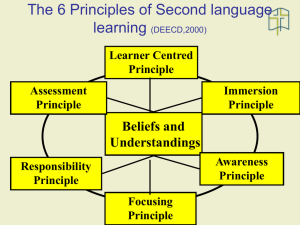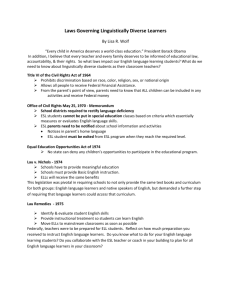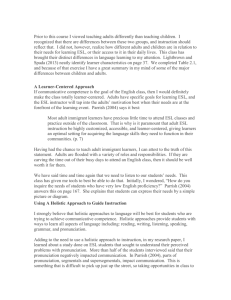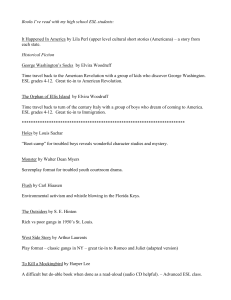English Years 7–10 units for ESL learners
advertisement
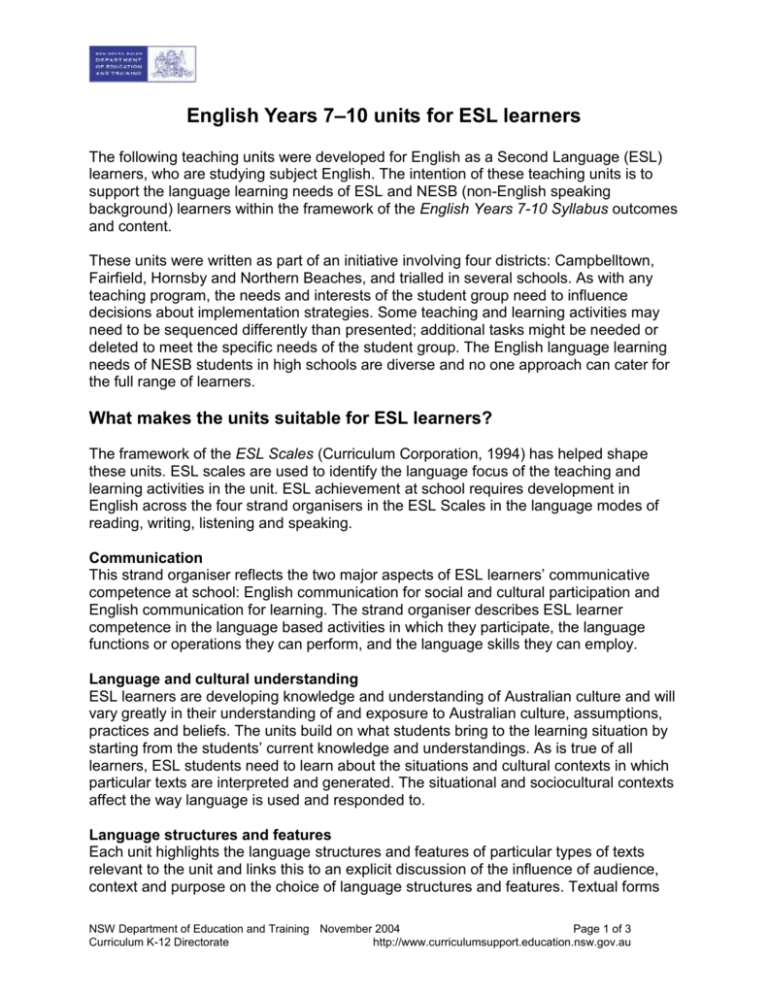
English Years 7–10 units for ESL learners The following teaching units were developed for English as a Second Language (ESL) learners, who are studying subject English. The intention of these teaching units is to support the language learning needs of ESL and NESB (non-English speaking background) learners within the framework of the English Years 7-10 Syllabus outcomes and content. These units were written as part of an initiative involving four districts: Campbelltown, Fairfield, Hornsby and Northern Beaches, and trialled in several schools. As with any teaching program, the needs and interests of the student group need to influence decisions about implementation strategies. Some teaching and learning activities may need to be sequenced differently than presented; additional tasks might be needed or deleted to meet the specific needs of the student group. The English language learning needs of NESB students in high schools are diverse and no one approach can cater for the full range of learners. What makes the units suitable for ESL learners? The framework of the ESL Scales (Curriculum Corporation, 1994) has helped shape these units. ESL scales are used to identify the language focus of the teaching and learning activities in the unit. ESL achievement at school requires development in English across the four strand organisers in the ESL Scales in the language modes of reading, writing, listening and speaking. Communication This strand organiser reflects the two major aspects of ESL learners’ communicative competence at school: English communication for social and cultural participation and English communication for learning. The strand organiser describes ESL learner competence in the language based activities in which they participate, the language functions or operations they can perform, and the language skills they can employ. Language and cultural understanding ESL learners are developing knowledge and understanding of Australian culture and will vary greatly in their understanding of and exposure to Australian culture, assumptions, practices and beliefs. The units build on what students bring to the learning situation by starting from the students’ current knowledge and understandings. As is true of all learners, ESL students need to learn about the situations and cultural contexts in which particular texts are interpreted and generated. The situational and sociocultural contexts affect the way language is used and responded to. Language structures and features Each unit highlights the language structures and features of particular types of texts relevant to the unit and links this to an explicit discussion of the influence of audience, context and purpose on the choice of language structures and features. Textual forms NSW Department of Education and Training November 2004 Page 1 of 3 Curriculum K-12 Directorate http://www.curriculumsupport.education.nsw.gov.au do not have universal conventions but vary according to culture. The conventions of the Australian academic cultural context are identified, discussed and where appropriate compared with the students’ own cultural conventions. Strategies This strand organiser reflects the strategic competence required to successfully acquire English as a new language. It involves the ability to assess, respond to and negotiate meanings as part of a dynamic process of language use. It focuses on language users and their language reception and production processes. The ESL Scales and English Content The ESL scales outcomes mapped to the content in the English Years 7-10 Syllabus have been selected from the ESL Scales document to show a pathway from the levels of language that ESL learners in Stages 4 and 5 may be working on, to the level of English that they need to have to achieve the English outcomes. They are not definitive and should be used as a guide. The teaching and learning activities detailed in these units draw on a wider range of ESL scales outcomes and performance pointers than those mapped to the English content. In addition: Vocabulary is a key issue for learners of English. Slang and colloquial expressions need to be explicitly taught as well as the language of formal academic English. Tasks that target the expansion of vocabulary support ESL learners to achieve English Years 7-10 Syllabus outcomes. Each unit includes worksheets and activities intended to broaden and consolidate students’ vocabulary, providing them with contextual information, content vocabulary and the metalanguage of subject English to enable them to engage in composing and responding to tasks in the units. Modelling and joint construction are important teaching strategies. ESL learners need to observe new language structures and features as well as practise using new language structures and features in a supportive environment. Each unit reflects the need for learners of English to notice, use, revisit and recycle new language through the teaching and learning cycle in the use of modelled, guided and independent composing tasks. Inclusivity is critical for ESL learners. The range of experiences, skills, knowledge and understandings of ESL learners will vary greatly depending on a number of factors, including literacy in their home language, experiences with formal schooling, and prior English language learning. Each unit provides opportunities for all learners to discuss their experiences, knowledge and understandings and make explicit connections and comparisons with their prior learning. The units are also inclusive through provision of diverse examples of characters and practices from countries and cultures. Unit duration The time students need to learn and practise new vocabulary, and new ways of making meaning, lends itself to units of greater length. A unit of longer than five weeks enables NSW Department of Education and Training November 2004 Page 2 of 3 Curriculum K-12 Directorate http://www.curriculumsupport.education.nsw.gov.au ESL learners to consolidate, expand and incorporate new vocabulary and language structures into their productive repertoire. This enables the student to respond to and compose more sophisticated texts with increasing confidence and independence. Rapid changes in topic and unit focus can lead to overload and prevent students from developing confidence and mastery in using the new language and way of using language. NSW Department of Education and Training November 2004 Page 3 of 3 Curriculum K-12 Directorate http://www.curriculumsupport.education.nsw.gov.au

